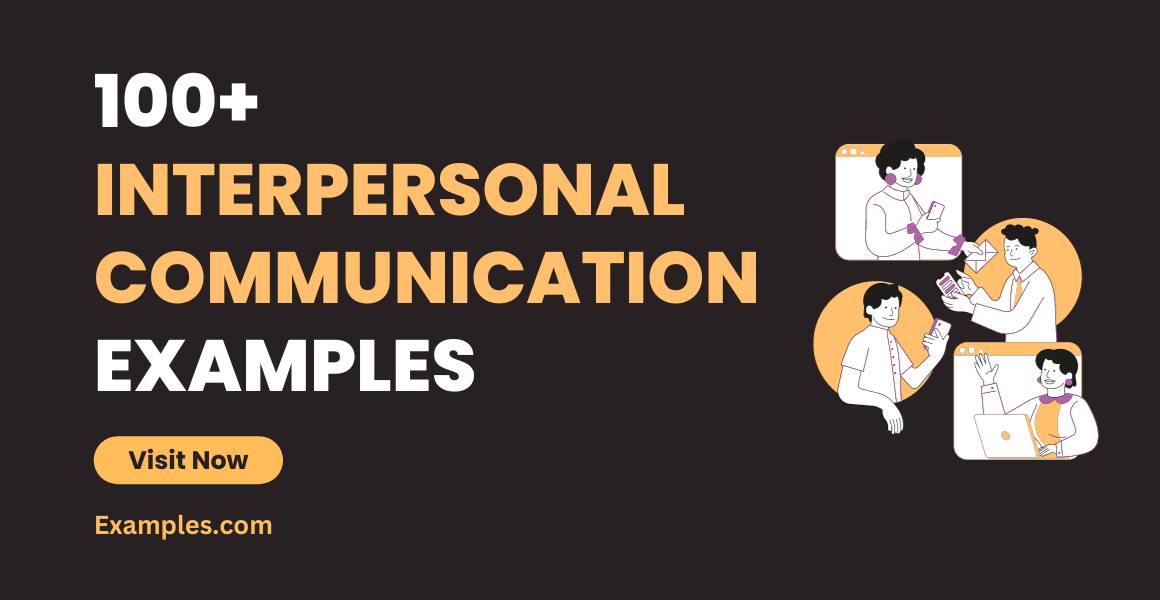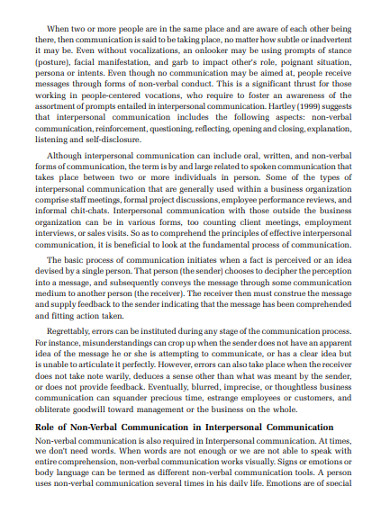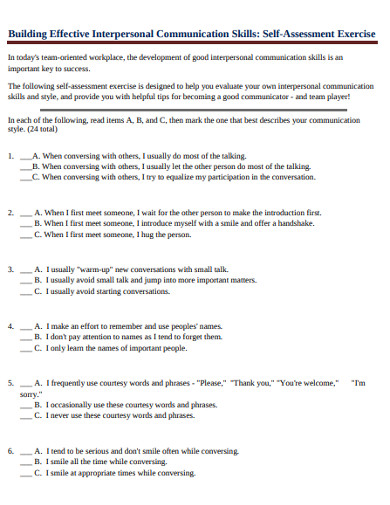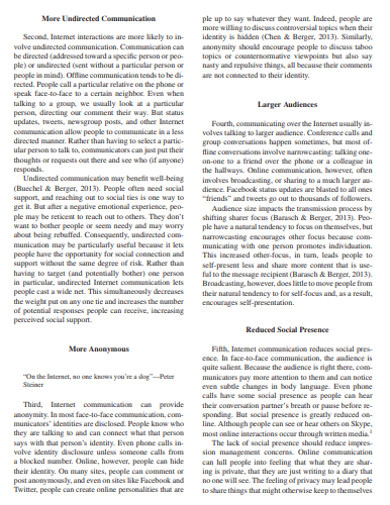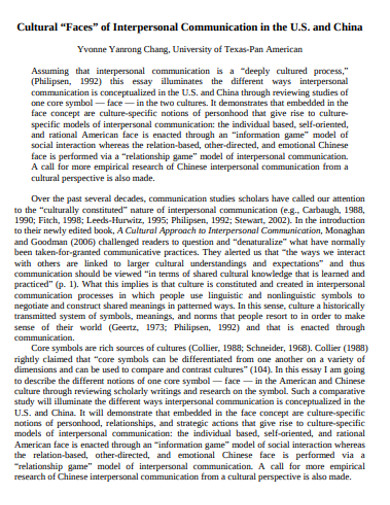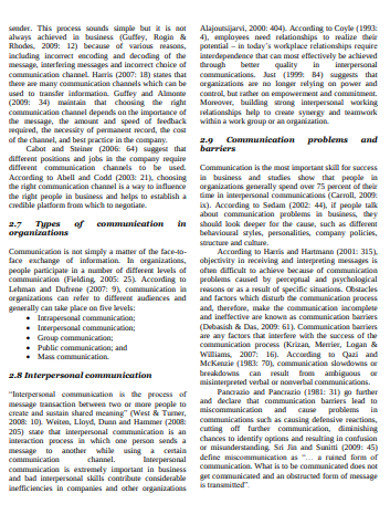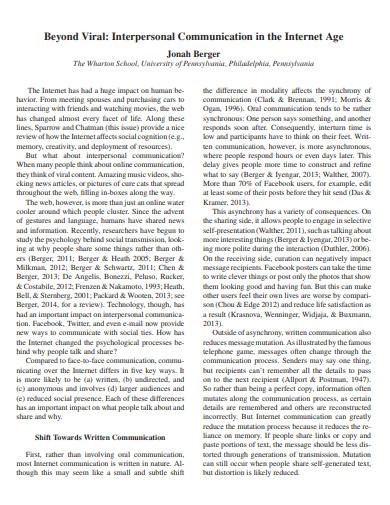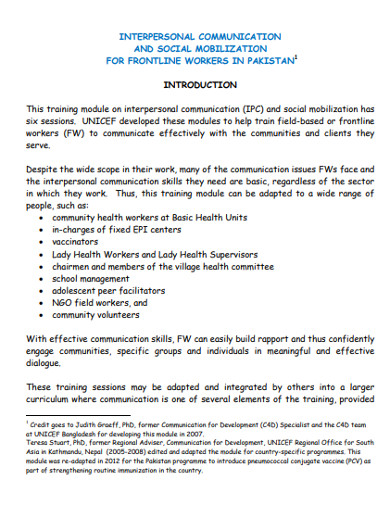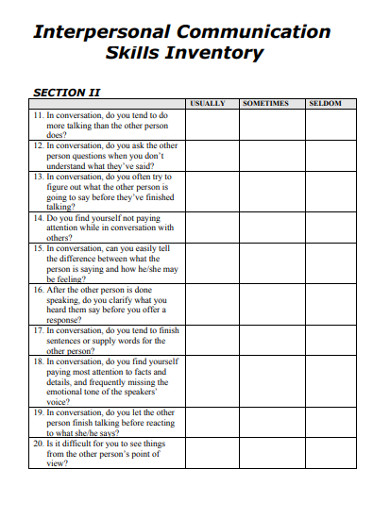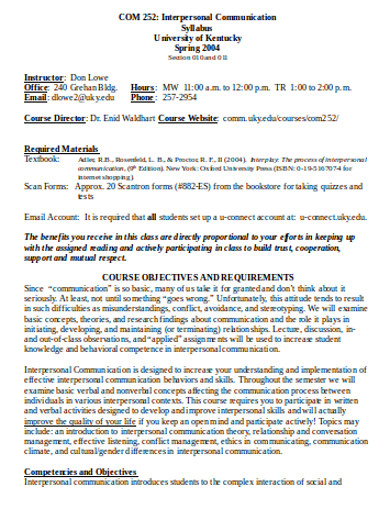100+ Interpersonal Communication Examples
Unveil the nuances of interpersonal communication with our comprehensive guide, brimming with examples and actionable tips. Whether it’s forging friendships, nurturing partnerships, or excelling in professional settings, our advice will empower your verbal and non-verbal interactions. Enhance your rapport and foster meaningful connections with the power of effective communication. Step into a world where every exchange is an opportunity for growth and understanding.
What is Interpersonal Communication? – Definition
Interpersonal communication is the process by which individuals exchange information, feelings, and meaning through verbal and non-verbal messages. It’s not just about speaking or writing, but also about how messages are received and interpreted, encompassing everything from a casual conversation to a heartfelt confession.
What is the Best Example of Interpersonal Communication?
A prime example of interpersonal communication is a one-on-one job interview. Here, both the interviewer and the interviewee use verbal language to convey messages, ask questions, and provide answers. Non-verbal cues like eye contact, body language, and tone of voice play a crucial role in conveying enthusiasm, confidence, and professionalism. This scenario encapsulates the essence of interpersonal communication, where both content and delivery impact the interaction’s effectiveness.
Why Do We Communicate?
We have different reasons as to why we interact with each other in the manner that we do. Humans are social animals, and we thrive in social interaction. It helped our species survive pre-civilization. Before the birth of civilization and language, as we know it today, we have been exchanging information with one another. We did so by producing sounds and gestures with known interpretations of that time. We survived and evolved together through cooperation.
It is also in communication that we learn. In fact, all our learning materials are different media of communication?—like letters, books, journals, chats, and speeches, that have transcended time in delivering information. Learning and the ability to communicate are impaired when a region of the brain responsible for the process is disturbed or damaged. Communication is, then, a social activity as it is a cognitive function of our brains exercised mechanically by our bodies.
100+ Interpersonal Communication Examples
- Active Listening in a Team Meeting: Paying close attention to a colleague’s presentation, nodding in agreement, and providing feedback that demonstrates understanding.
- Conflict Resolution Between Friends: Using “I” statements to express feelings without blaming and working together to find a mutually agreeable solution.
- Constructive Criticism in a Peer Review: Offering balanced feedback that highlights strengths while also suggesting areas for improvement in a respectful manner.
- Empathetic Response During a Counseling Session: Reflecting a client’s feelings and summarizing their words to show comprehension and compassion.
- Non-verbal Encouragement During a Presentation: Smiling and giving a thumbs-up to a nervous speaker to boost their confidence.
- Open-ended Questions in a Sales Consultation: Asking prospective customers about their needs to better tailor the sales pitch to their specific situation.
- Paraphrasing in a Negotiation: Repeating the other party’s points in your own words to confirm understanding and continue the dialogue.
- Summarizing the Conclusion of a Debate: Restating the main points made by both sides to clarify the discussion’s outcome.
- Comforting Body Language in a Support Group: A gentle touch on the shoulder or a warm, open posture to convey empathy and support.
- Clarifying Statements in a Customer Service Call: Asking for more details or rephrasing the customer’s issues to ensure correct understanding and provide appropriate solutions.
- Acknowledging a Colleague’s Success: Congratulating a coworker on a well-executed project during a team meeting.
- Expressing Appreciation to a Mentor: Sharing a heartfelt thank you with a mentor for their guidance and support over the years.
- Discussing Career Goals with a Supervisor: Having a one-on-one discussion with your supervisor about your professional aspirations and potential career path.
- Providing Comfort to Someone Grieving: Offering words of sympathy and a listening ear to a friend who has recently experienced a loss.
- Negotiating Terms with a New Client: Engaging in a back-and-forth dialogue to establish the terms of a new business agreement.
- Sharing Constructive Feedback with a Teammate: Communicating ways to improve while recognizing the effort already put forth by a teammate.
- Brainstorming Ideas in a Group Setting: Collaboratively generating ideas with a group, building on each other’s suggestions.
- Engaging in Small Talk with Acquaintances: Exchanging pleasantries and light conversation at a social gathering or before a meeting begins.
- Resolving Misunderstandings with a Partner: Addressing and clarifying any miscommunications to prevent further conflict in a relationship.
- Asking for Help on a Difficult Task: Reaching out to a colleague for assistance when you’re facing a challenging work task.
- Giving Directions to a Tourist: Providing clear and helpful guidance to someone visiting your city for the first time.
- De-escalating a Heated Argument: Using calming language and non-threatening body language to diffuse a tense situation.
- Sharing Exciting News with Family: Communicating a personal achievement or milestone with loved ones.
- Conducting a Performance Review with an Employee: Discussing performance, setting goals, and giving feedback in a formal review setting.
- Listening to a Child’s Concerns: Offering undivided attention to understand a child’s worries or fears.
- Apologizing for a Mistake: Owning up to an error and expressing sincere regret to those affected.
- Expressing Concern for a Friend’s Well-being: Reaching out to check on a friend going through a tough time and offering support.
- Collaborating with Coworkers on a Project: Sharing ideas and responsibilities to achieve a common goal with your team.
- Receiving Critical Feedback Graciously: Listening to and acknowledging critical feedback without becoming defensive.
- Participating in a Cultural Exchange Program: Sharing your culture and learning about others in an exchange of customs and language.
- Guiding a New Employee Through Onboarding: Explaining company policies and offering insights into the workplace culture to a newcomer.
- Motivating a Team Before a Big Challenge: Delivering an inspiring talk to rally a team and boost morale before tackling a significant challenge.
- Breaking Difficult News with Empathy: Communicating unfortunate news in a way that is sensitive to the receiver’s emotions.
- Celebrating a Retirement with a Speech: Honoring a retiring colleague with a speech that reflects on their contributions and wishes them well.
- Asking Insightful Questions in a Workshop: Engaging with a speaker by asking questions that delve deeper into the topic.
- Negotiating a Compromise in a Relationship: Working with a significant other to find a middle ground that respects both parties’ needs.
- Participating Actively in a Seminar: Contributing to a seminar with relevant comments and questions that enhance the discussion.
- Reconnecting with an Old Friend: Rekindling a friendship by reminiscing and catching up on each other’s lives.
- Facilitating a Support Group Session: Leading a group in sharing their experiences and offering mutual support in a safe space.
- Persuading Someone to Consider a New Perspective: Using logical and emotional appeals to encourage someone to see a different point of view.
- Coordinating Community Service Volunteers: Organizing a group of volunteers, assigning tasks, and ensuring the group’s objectives are met.
- Encouraging a Peer to Continue Their Education: Providing reasons and motivation for a friend to pursue further education or training.
- Leading a Meditation Class: Guiding participants through a meditation session with calming instructions and a soothing tone.
- Presenting a Toast at a Wedding: Delivering a heartfelt message that celebrates the couple and shares joy with the guests.
- Debating a Topic in a Civic Meeting: Engaging in a civil discussion over community issues, presenting arguments, and considering others’ viewpoints.
- Expressing Love and Commitment in a Relationship: Sharing feelings of love and discussing the future with a romantic partner.
- Offering Technical Support Over the Phone: Helping a customer troubleshoot an issue with clear, patient instructions.
- Teaching a Class Using Relatable Examples: Explaining a complex subject by relating it to the students’ everyday experiences.
- Counseling a Friend Through Career Choices: Offering advice and support as a friend contemplates different career paths.
- Engaging with Followers on Social Media: Responding to comments and messages in a way that fosters community and connection.
- Hosting a Panel Discussion: Moderating a discussion by introducing topics and managing the dialogue between panelists.
- Mediating a Dispute: Helping two parties find common ground and reach a resolution through guided discussion.
- Providing Directions to a New Employee: Clearly explaining the layout of the workplace and procedures to a new hire.
- Expressing Gratitude to a Team: Showing appreciation for a team’s hard work and dedication after completing a project.
- Giving a Eulogy: Sharing memories and comforting words to honor someone who has passed away.
- Interviewing a Subject Matter Expert: Asking in-depth questions to uncover insights for an article or research project.
- Teaching a Safety Procedure: Instructing employees on new safety protocols with clear and concise information.
- Delivering Constructive Peer Feedback: Sharing observations and suggestions for improvement in a peer’s project or performance.
- Networking at a Conference: Engaging with professionals by sharing interests and exchanging contact information.
- Counseling a Couple: Facilitating open communication between partners to address relationship issues.
- Pitching an Idea to Investors: Convincingly presenting a business idea to potential investors, highlighting benefits and addressing concerns.
- Facilitating a Workshop: Guiding participants through activities and discussions to achieve the workshop’s learning objectives.
- Requesting Feedback on a Manuscript: Seeking constructive criticism from peers on a written work to improve its quality.
- Conducting a Therapy Session: Engaging with a client to explore their thoughts and feelings in a therapeutic setting.
- Offering Sympathy in Times of Loss: Sharing words of comfort to someone who is grieving a loss.
- Leading a Team Huddle: Briefing a team on the day’s goals and encouraging team spirit.
- Negotiating a Contract: Discussing terms and conditions to reach an agreement that benefits all parties involved.
- Coaching a Sports Team: Motivating athletes with strategic advice and positive reinforcement.
- Delivering a Graduation Speech: Inspiring graduates by reflecting on past achievements and offering advice for the future.
- Instructing a Fitness Class: Guiding participants through exercise routines with clear and encouraging directions.
- Participating in a Book Club: Discussing themes, characters, and personal interpretations of a book with fellow readers.
- Receiving a Performance Appraisal: Listening to and reflecting on an evaluation of one’s work performance.
- Guiding a Tour Group: Sharing historical facts and stories with visitors in an engaging manner.
- Presenting a Scientific Poster: Explaining research findings to peers at a conference with concise and informative language.
- Soliciting Donations for a Cause: Communicating the importance of a cause to potential donors to gain their support.
- Leading a Religious Service: Delivering a sermon or message that connects with the congregation.
- Directing a Theater Rehearsal: Giving actors feedback and direction to refine their performance.
- Teaching a Cooking Class: Demonstrating techniques and sharing culinary tips with students.
- Providing Customer Service: Addressing customer inquiries and resolving issues with professionalism and empathy.
- Hosting a Radio Show: Engaging listeners with interesting topics, music, and conversation.
- Participating in a Diplomatic Meeting: Discussing international relations with tact and cultural sensitivity.
- Managing a Crisis Response: Coordinating a team’s response to an emergency with clear and decisive communication.
- Delivering a Policy Briefing: Informing stakeholders about policy changes and their implications.
- Celebrating a Team Achievement: Recognizing the efforts of a team and celebrating their success together.
- Discussing Health Diagnoses with Patients: Communicating medical information to patients in an understandable and compassionate manner.
- Leading a Community Initiative: Rallying community members to participate in a local project or event.
- Facilitating a Focus Group: Gathering qualitative data through guided group discussions on a product or service.
- Debating in an Academic Competition: Articulating arguments and rebuttals in a structured format.
- Conducting a Parent-Teacher Conference: Sharing a student’s progress and collaborating on strategies for improvement.
- Motivating Volunteers for a Charity Event: Inspiring a group of volunteers to contribute their best efforts for a charitable cause.
- Reporting News as a Journalist: Delivering news with objectivity and clarity to inform the public.
- Teaching a Language: Using immersive techniques to help students grasp a new language.
- Participating in Peer Counseling: Offering support and advice to peers in a non-professional counseling capacity.
- Hosting a Gala Event: Welcoming guests and ensuring the event’s program runs smoothly.
- Leading a Yoga Class: Instructing participants with calming and clear directions to enhance their practice.
- Delivering a Product Demonstration: Showcasing a product’s features and benefits to potential customers.
- Facilitating an Art Workshop: Encouraging creativity and providing artistic guidance to participants.
- Providing Legal Advice: Explaining legal options and implications to clients in a clear, accessible manner.
- Moderating a Public Forum: Managing discussions and audience questions during a public meeting.
- Conducting a Science Experiment with Students: Guiding students through a scientific procedure, fostering curiosity and learning.
Interpersonal Communication Sentence Examples
Harness the art of interpersonal exchange with these tailored sentence examples. Perfect for refining dialogue, they serve as blueprints for crafting messages that resonate and engage. Whether it’s personal or professional, these examples provide a guide for clear, empathetic, and effective communication.
- Expressing Empathy: “I can see this situation is really tough on you; how can I help?”
- Providing Feedback: “Your report was very thorough, but I think adding more data analysis could enhance it further.”
- Making a Request: “Could you please send me the files by this afternoon so I have time to review them?”
- Sharing Information: “I’ve updated the project timeline to reflect the new deadlines we discussed.”
- Apologizing: “I apologize for the oversight; I’ll take steps to ensure it doesn’t happen again.”
Interpersonal Communication Examples in Everyday Life
Daily interactions are filled with moments that shape our relationships and experiences. These examples demonstrate how we connect and communicate in various personal situations.
- Asking for Assistance: “Can you help me carry this? It’s a bit too heavy for me.”
- Declining an Invitation Politely: “Thank you for the invite, but unfortunately, I have a prior commitment.”
- Initiating Small Talk: “Lovely weather we’re having today, isn’t it?”
- Making Plans with Friends: “Are we still on for dinner at 7 pm tonight?”
- Complimenting Someone: “That’s a lovely dress; the color really suits you!”
Interpersonal Communication Examples in TV Shows
TV shows offer a plethora of interpersonal communication dynamics that reflect and exaggerate real-life scenarios.
- Resolving Conflicts: Characters often have heart-to-heart talks to resolve misunderstandings.
- Expressing Love: Romantic dialogues in TV shows encapsulate the expression of deep affection.
- Mentoring: Many shows feature a wise character imparting knowledge to a less experienced one.
- Negotiating: Reality TV often showcases people negotiating deals or resolving disputes.
- Forming Alliances: Competition-based shows frequently depict contestants forming strategic alliances through dialogue.
Interpersonal Communication Examples in Movies
Movies provide rich examples of interpersonal communication, from iconic monologues to powerful one-liners.
- Heroic Speeches: Protagonists often give rousing speeches to motivate and inspire others.
- Villain Monologues: Antagonists reveal their motives and plans through intense monologues.
- Romantic Declarations: Love interests confess their feelings in poignant, memorable scenes.
- Character Development: Dialogue between characters often drives their development and the plot.
- Comic Relief: Witty banter between characters provides levity and humor.
Interpersonal Communication Examples in the Workplace
The workplace is a hub of professional interaction, where communication is key to success.
- Team Collaboration: “Let’s brainstorm to come up with the best solution for our client.”
- Leadership: “I trust your judgment on this; let’s lead the team to success.”
- Delegation: “I would like you to take the lead on this project; I believe in your skills.”
- Professional Critique: “Your concept is innovative, but we need to consider the budget constraints.”
- Networking: “It was great meeting you at the conference; let’s keep in touch.”
Interpersonal Communication Scenario Examples
Scenarios provide context to interpersonal communication, illustrating how words and actions are perceived.
- Customer Service: A customer service representative patiently handles a customer’s complaint and provides a solution.
- Job Interview: An applicant articulates their skills and aligns them with the company’s needs.
- Performance Review: A manager gives constructive feedback and sets goals for an employee’s growth.
- Family Dispute: Family members use ‘I feel’ statements to express their perspectives and reach a consensus.
- Community Meeting: Residents discuss neighborhood issues and collaborate to find actionable solutions.
10+ Interpersonal Communication Examples in PDF, DOC
Maintaining good interpersonal communication skills are important in your life and in society at large. In an individual sense, effective communication can take us far in life. Browse through the following examples that may help you improve how you can communicate with others.
1. Student Interpersonal Communication Example
2. Sample Interpersonal Communication Example
3. Basic Interpersonal Communication Example
4. Building Effective Interpersonal Communication Example
5. Standard Interpersonal Communication Example
6. Cultural Interpersonal Communication Example
7. Communication Channels and Interpersonal Example
8. Interpersonal Communication in the Internet Age Example
9. Interpersonal Communication and Social Mobilization Example
10. Interpersonal Communication Skills Inventory Example
11. Interpersonal Communication in DOC
Communicating Effectively
Anyone can talk, and anyone can listen. Effective communication calls for a tango of talking and listening, even when you are the one speaking. You have to make sure that the message you are sending is received as intended by listening and honing into the cues that your audience is displaying during the present interaction. Add the following tips to your checklist of how to improve your communication.
1. Make Eye Contact
When you are addressing someone, you look at them in the eye. Eye contact exudes confidence. It also helps you evaluate the effect of the interaction on the recipient of the information you’re giving. When you’re speaking to a crowd, remember to include everyone in the conversation by making eye contact with them. By looking at the person you’re talking to, you can get feedback in real-time. You can change your delivery, pause, add an adlib, or entertain the confusion, so as to make sure that you are not misunderstood.
2. Adjust Speaking Pace
Talking, as you know, is different from writing. You have to verbally articulate your thoughts. This gets harder when you are to give an impromptu speech where you don’t have the luxury of practice time. Some of us may have the tendency to synchronize our speaking pace with our thought process. Speaking this way will render what you say hard to understand at times. Relax and take the time to enunciate the words properly and clearly. Pauses will also help you gather your thoughts.
3. Take Up Space
When you’re delivering a speech in a podium, don’t just stay rigid in one area. You don’t have to move dramatically from one area to another every minute. It’s also not good to stay in one place in space and time for an hour-long talk, especially when you don’t have visually stimulating visual aids. You can move a few steps away from your point of origin. Use your hands to deliver your point, as well. Limp hands at your sides would make you seem robotic and unnatural.
4. Remember Your Audience
Even if we keep our social circles close-knit and exclusive only to people sharing our interests, we cannot avoid interacting with people who don’t understand jargons that we consider colloquial. We are bound to talk to them, either through everyday conversations or formal speeches. Therefore, both speaker and listener should meet halfway by using terminologies and illustrations that are familiar to both parties. Remember that communication is an exchange of ideas through known language system by both the speaker and the audience. Alienating your audience just to sound smart disregards that goal.
Types of Interpersonal Communication
Listening: This is an active process where attention is given to the speaker’s message, allowing for understanding and appropriate feedback. It’s fundamental in all types of communication.
Nonverbal Communication: This includes all the messages we send without words, such as facial expressions, body language, gestures, posture, and even the physical distance between communicators.
Verbal Communication: The use of spoken words to convey a message. This can include face-to-face conversations, telephone calls, radio broadcasts, and any other medium that requires speaking and listening.
Teamwork: Involves collaborating and communicating effectively with others within a group to achieve a common goal. Successful teamwork relies on clear, open communication among all members.
Written Communication: The act of writing messages in letters, emails, texts, and other written documents. It’s a key component in formal and long-distance communication.
Empathy: The ability to understand and share the feelings of another person, which is essential for building rapport and trust in communication.
Gestures: Body movements, such as hand signals or nods, that are used to aid expression and help convey messages alongside or instead of verbal communication.
Meetings: Formal or informal gatherings where two or more people engage in discussion to exchange information or reach a decision.
Oral Communication: Similar to verbal communication, this involves expressing ideas through the spoken word. It’s often used in presentations and everyday conversations.
Phone Calls: A type of verbal communication that takes place over the phone, allowing for instant vocal interaction between parties without the need for physical presence.
Presentations: A formal method of communication that involves speaking to an audience with the aim of informing, persuading, or motivating them.
Problem Solving: This involves communicating to identify an issue and develop strategies for resolution. It often requires clear articulation of the problem and collaborative discussion for solutions.
Text Messages: A form of written communication that is brief and intended for instant exchange of information via mobile devices or online platforms.
Each of these components plays a vital role in interpersonal communication, contributing to the richness and effectiveness of personal interactions. They are the building blocks that facilitate connection, collaboration, and understanding in both personal and professional contexts.
What are the Characteristics of Interpersonal Communication?
Interpersonal communication is distinguished by several key characteristics that make it a unique and essential human activity:
- Directness: Most often, interpersonal communication is direct, with the exchange occurring between individuals in real-time.
- Personalization: Communication is tailored to the individual, making it a highly personal interaction that can be influenced by the relationship between the parties.
- Feedback: It allows for immediate feedback, enabling clarification and adjustment in the flow of communication.
- Two-way Process: It involves both sending and receiving messages, making it a dynamic two-way process.
- Contextual: Interpersonal communication is influenced by the context in which it occurs, including cultural, social, and relational contexts.
Why is Interpersonal Communication Important?
Interpersonal communication is the foundation upon which relationships are built, maintained, and sometimes ended. Its significance lies in several key areas:
- Building Connections: Effective interpersonal communication fosters strong relationships both personally and professionally.
- Facilitating Understanding: It’s crucial for mutual understanding and for navigating the complexities of human emotions and thoughts.
- Conflict Resolution: Through open and honest communication, conflicts can be resolved and misunderstandings clarified.
- Influencing and Persuasion: Persuasive communication can influence opinions and motivate changes in behavior or attitude.
- Personal and Career Success: Proficiency in interpersonal communication is often linked to personal satisfaction and professional advancement.
What are Interpersonal Communication Principles?
Interpersonal communication principles serve as the foundational guidelines that govern the dynamics of interaction between individuals. These principles encompass clarity, which ensures the message is understandable; listening, which involves not just hearing but actively understanding the content and emotion behind the message; feedback, providing a response to the received message; and respect, acknowledging each other’s views and treating each interaction with consideration and empathy. Adaptability is also key, as it requires adjusting communication styles to fit different contexts and personalities. Ethical communication, which upholds honesty and integrity, and cultural awareness, which recognizes and respects diversity, are also critical principles guiding effective interpersonal communication.
What is the Concept of Interpersonal Communication?
The concept of interpersonal communication is the exchange of information between two or more people. It is a multifaceted process that includes not only the spoken or written words but also the unspoken elements like tone of voice, body language, facial expressions, and personal space. The concept extends beyond mere data transmission to encompass the creation of shared meaning and the establishment of relationships. It involves the ability to influence others, negotiate misunderstandings, and build trust and rapport. At its core, interpersonal communication is about connection and the ways we convey and interpret messages in various contexts.
What are the Key Points to Consider in Interpersonal Communication?
In interpersonal communication, several key points warrant consideration:
- Context: Understanding the situational and cultural context can greatly influence the effectiveness of communication.
- Clarity: Being clear and concise helps prevent misunderstandings and conveys messages more effectively.
- Active Listening: This involves engaging fully with the speaker, showing interest, and providing feedback that promotes a two-way interaction.
- Non-verbal Cues: These often convey more information than words and include facial expressions, body language, gestures, and tone of voice.
- Emotional Intelligence: Recognizing and managing your emotions, as well as identifying and responding appropriately to the emotions of others, is vital.
- Barriers to Communication: Identifying and overcoming barriers, such as language differences, distractions, or biases, is important for clear communication.
- Feedback: Giving and receiving feedback is essential to confirm understanding and to continue the dialogue.
- Respect and Empathy: Showing respect and empathy builds trust and strengthens the relationship between communicators.
- Adaptability: Adjusting your communication style to the audience and context can improve comprehension and engagement.
- Consistency: Ensuring your words match your actions builds credibility and trust.
These key points are the bedrock of successful interpersonal communication, ensuring that interactions are not only understood but also create positive connections and outcomes.
What are the Purposes of Interpersonal Communication?
Interpersonal communication serves several fundamental purposes that facilitate human connections in every aspect of life:
- Information Sharing: At its core, interpersonal communication is about exchanging information, whether it’s sharing news, disseminating knowledge, or conveying ideas.
- Relationship Building: Communication is the cornerstone of relationship building, fostering connections between individuals through shared experiences and emotional exchanges.
- Identity Formation: Through interactions with others, individuals shape and express their identities, reinforcing their self-concept and how they are perceived by others.
- Emotional Expression: Interpersonal communication is a primary means of expressing emotions, allowing individuals to share feelings like joy, anger, love, and sadness.
- Influence and Persuasion: It is used to influence others’ thoughts and actions, from simple persuasion to more complex negotiations.
- Conflict Resolution: Effective communication is vital in resolving misunderstandings and disputes, helping to maintain harmonious relationships.
- Decision Making: Collaborative decision-making processes rely on clear communication to weigh options and come to a consensus.
- Problem Solving: Interpersonal communication is essential in problem-solving, where discussing and brainstorming can lead to effective solutions.
These purposes highlight the multifaceted role of interpersonal communication in personal and professional settings, emphasizing its importance in achieving a well-functioning society.
What is the Function of Interpersonal Communication?
The function of interpersonal communication is multifaceted and dynamic:
- Social Interaction: It facilitates social interaction, which is essential for mental health and establishing a sense of community.
- Coordination of Efforts: In both personal and professional settings, communication is key to coordinating efforts towards a common goal.
- Socialization: Through communication, individuals learn social norms, cultural values, and appropriate behaviors.
- Self-expression: It provides a channel for self-expression, allowing individuals to share their thoughts, ideas, and creativity.
- Emotional Support: Offering and receiving emotional support through communication is critical for maintaining relationships and personal well-being.
- Education and Learning: Teaching and learning are fundamentally reliant on clear communication to impart and understand new information.
- Entertainment: Interpersonal communication can entertain, as seen in storytelling, humor, and everyday conversations that bring joy.
These functions underscore the complex role of interpersonal communication in shaping human experiences, driving social progress, and enriching personal growth.
How do you Use Interpersonal Communication? – Step by Step Guide
Effective interpersonal communication is a skill that can be honed with practice and intention. Here’s a step-by-step guide to using it effectively:
- Identify the Purpose: Begin by understanding the purpose of your interaction. Is it to inform, persuade, build a relationship, or resolve an issue?
- Know Your Audience: Tailor your communication style to your audience. Consider their background, preferences, and level of understanding.
- Choose the Right Channel: Select an appropriate medium for your message, whether it’s face-to-face, a phone call, an email, or a text message.
- Prepare Your Message: Plan what you want to say. Organize your thoughts clearly and anticipate possible questions or reactions.
- Engage in Active Listening: Show that you are listening actively by maintaining eye contact, nodding, and providing verbal affirmations.
- Use Clear and Concise Language: Avoid jargon and speak plainly to ensure your message is understood.
- Observe Non-Verbal Cues: Pay attention to body language, facial expressions, and tone of voice, both in yourself and in your communication partner.
- Provide Feedback: Offer feedback when necessary to clarify and confirm understanding.
- Be Empathetic: Try to understand the other person’s point of view and respond with sensitivity.
- Follow Up: If necessary, follow up to ensure that your message was understood and to maintain the communication loop.
Tips for Using Interpersonal Communication
- Be Mindful of Cultural Differences: Recognize and respect cultural nuances in communication styles.
- Practice Emotional Intelligence: Be aware of and control your emotions, and handle interpersonal relationships judiciously and empathetically.
- Be Adaptable: Adjust your communication style as the situation demands.
- Maintain a Positive Attitude: A positive demeanor can enhance the quality of your interactions.
- Develop Your Listening Skills: Good communication isn’t just about speaking well; it’s also about listening effectively.
- Be Open to Feedback: Use feedback as an opportunity to improve your communication skills.
- Practice Assertiveness: Express your thoughts, feelings, and needs directly and respectfully.
- Be Authentic: Authenticity fosters trust and strengthens connections.
- Use “I” Statements: Reduce defensiveness in others by speaking from your own perspective.
- Clarify and Summarize: Ensure mutual understanding by summarizing and repeating back what you’ve heard.
- Keep Confidentiality: Respect privacy to build trust in your communication relationships.
- Avoid Assumptions: Don’t jump to conclusions; clarify when in doubt.
- Continuously Improve: View every interaction as an opportunity to refine your communication skills.
Following these steps and tips can help anyone use interpersonal communication more effectively, enhancing both personal and professional relationships.


